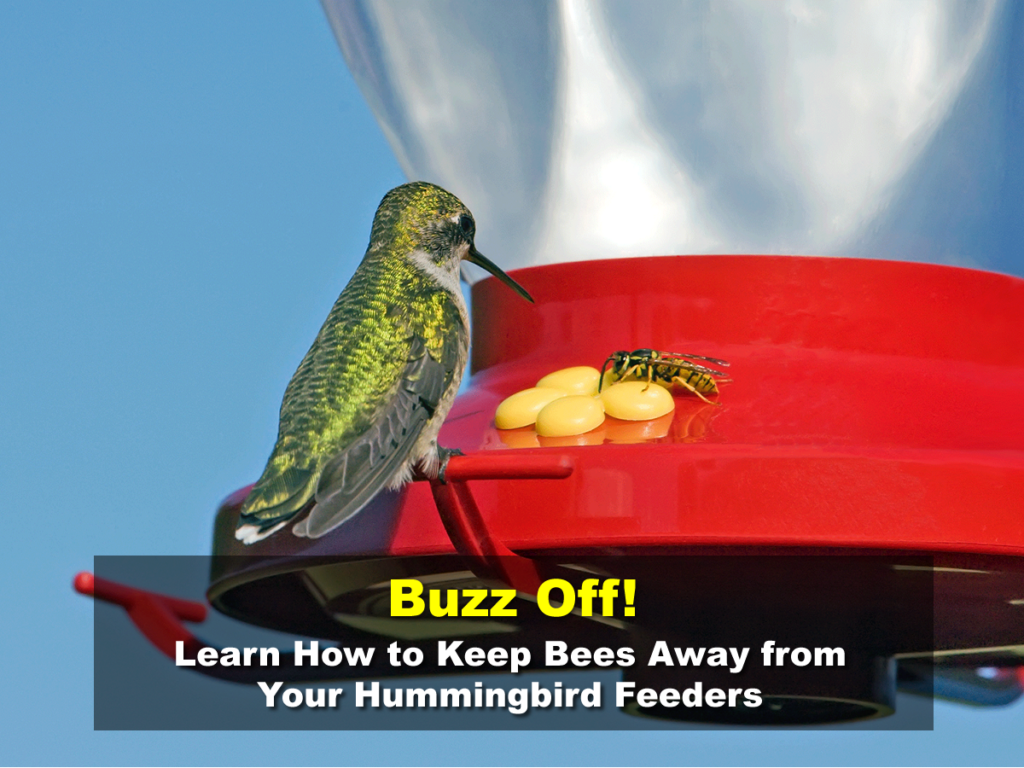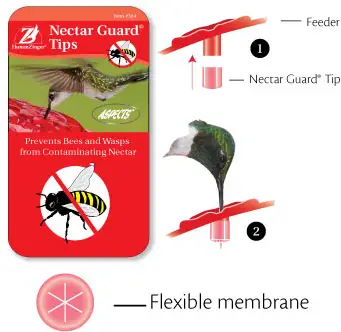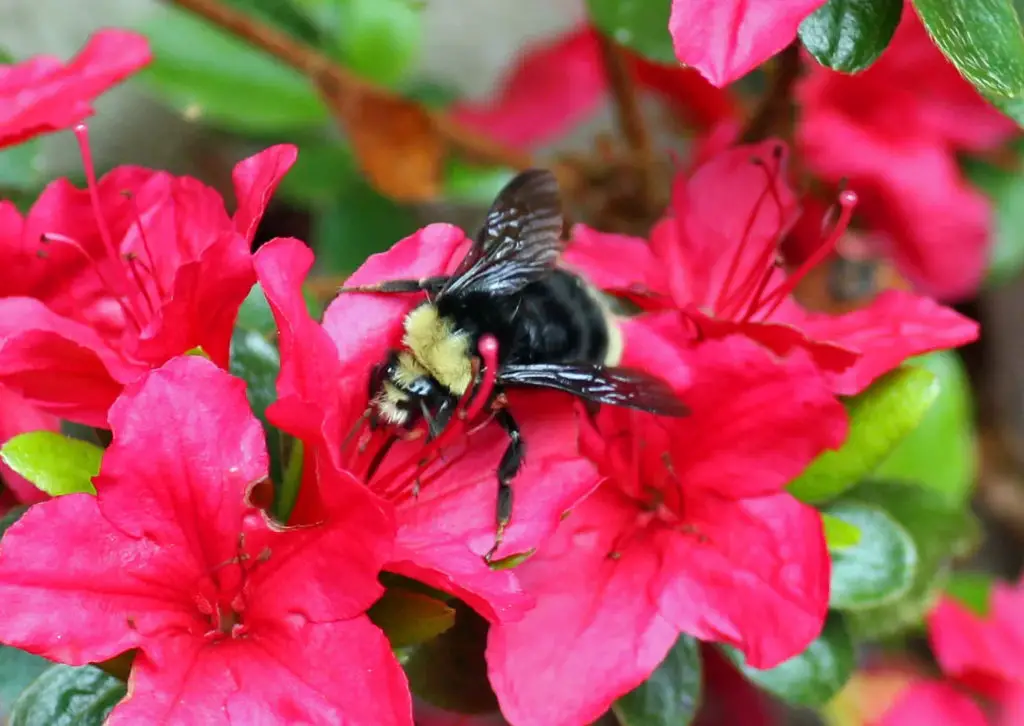Affiliate Disclaimer - As an Amazon Associate I earn from qualifying purchases.
It supports the website. So, Thank you
Unlike most bird species, hummingbirds don’t feed on fruits, seeds, or insects. Instead, they feed on nectar, just like bees do. Bird lovers all over the United States hang hummingbird feeders filled with sugar water to give these beautiful birds some additional sustenance.
However, while bees are welcome in most gardens, they can become a pest when they’re gathered around these feeders which leads many homeowners to wonder how to keep bees away from hummingbird feeders.
There are several things you can do to prevent bees from coming to your hummingbird feeders such as using nectar guards or opting for a red feeder. However, you should not use any chemical pesticides as these will do more harm than good.
In this guide, I’d like to share some natural ideas on keeping those bees at bay and allowing your local hummingbirds to enjoy their sugar water in peace.
Why Can’t I Use Pesticides?
I cannot stress enough the importance of not using chemical pesticides in and around your hummingbird feeder. Yes, these products will deal with the bee problem and will eradicate any that come into contact with them. However, pesticides can also harm hummingbirds and that isn’t what we want.
What’s more, while bees might be a pest around your feeders, they’re also an essential part of the ecosystem. In any situation, I would never recommend using pesticides or killing bees because this can do damage to the local ecosystem.
Natural Ways To Keep Bees Away From Hummingbird Feeders
I’ve spoken to a lot of people that are under the belief that avoiding chemicals means that they’ll just have to resign themselves to the fact that bees will be a bother. But this isn’t the case. If you’re having problems with buzzing visitors around your feeders then there are lots of ways to tackle this without harming any wildlife.
Check Your Feeder For Leaks
Before you do anything else, it’s worth checking that your hummingbird feeder is in tip-top condition. In some cases, you may notice that bees start visiting your feeder in much larger numbers and more frequently than they ever have before. If this happens then there’s a very good chance that there is a leak somewhere on the feeder.
As the sugar water drips out of the feeder, this is like an open call to any bees within the local area and they’ll come in their dozens.
But you might not need to invest in a new feeder just yet; there’s a chance that you can fix the problem. If the leak is continuous then you will need to plug it which can be easily done using some plumber’s tape. Make sure that the tape doesn’t go anywhere near the sugar water though as there could be components in the adhesive that may be detrimental to the health of the birds.
Hummingbird Feeder Placement
Another thing that’s really important to think about when trying to keep bees away is where you place your hummingbird feeder. I would always recommend putting it in a shaded area as this is going to make feeding more comfortable for the birds and will prevent the sugar water from fermenting too quickly.
However, this is also ideal as shade acts as a deterrent for bees. Bees usually like to be in full sun when they are feeding and are unlikely to be attracted to a nectar source that’s in complete shade. Think about when you see the bees flying between flowers; they’re almost always in direct sunlight.
On top of this, I would suggest rotating the position of your hummingbird feeder almost as a way of confusing the bees. These are intelligent creatures that will return to a known food source and even bring other bees back with them. By regularly moving the feeder, you’ll throw them off the scent.
You don’t need to move them right to the other side of the yard. In fact, this probably isn’t the best idea. But even just moving the feeders a few feet can have the desired effect.
Don’t Make It So Sweet
Did you know that bees (and wasps) prefer much sweeter sugar water than hummingbirds? In fact, you could use a ratio of 5:1 and this would still be sweet enough for the birds. However, bees tend to prefer a ratio of 3:1 so they’ll be much less likely to show an interest and the hummingbirds can feed in peace.
Using Red Hummingbird Feeders
When you shop for hummingbird feeders, you will notice that a lot of products are red. This isn’t an aesthetic thing and has more to do with the fact that bees aren’t attracted to this color. In fact, it’s believed that they’re completely unable to see red so having a red feeder won’t act as a bright beacon to them.
Avoid colors like yellow and purple as these are some of the bees’ favorites. Even if the feeder has small decorative pieces in a different color, it’s worth removing these if they’re going to attract bees. If they cannot be removed then it’s perfectly possible to paint them red as long as you use a paint that won’t be toxic to the hummingbirds.
Use A Saucer Style Feeder
There are several different designs when it comes to hummingbird feeders but I find that the saucer style is the most effective when it comes to deterring bees. These are great because they’re designed to allow hummingbirds to access the nectar with their long tongues. However, the sugar water remains inaccessible to bees, wasps and other insects.
If you’re also having problems with ants then I’d recommend suspending the feeder using a fishing line as this is incredibly difficult for these critters to climb.
Buy a hummingbird feeder:
Use A Nectar Guard
There’s one thing that bees are looking for when they flock around your hummingbird feeders; nectar. But if they can’t get to it then they’ll soon get bored and go looking for food elsewhere. That’s why a nectar guard is a fantastic way to keep bees away.
You can buy these for most feeders but if you prefer to be creative then it’s entirely possible to make your own. The idea is simply to make the hole too small for bees to get into while still allowing hummingbirds to use their tongues to sip the nectar.
There are even some hummingbird feeders that come with ready-installed bee guards so you don’t need to worry about a thing.
Plant Bee-Friendly Flowers
Bees would much rather take their nectar from flowers but if they stumble upon a hummingbird feeder filled with sugar water in a garden where there aren’t any flowers, they’ll take what they can get.
It’s for this reason that I’d encourage you to create a small pollinator area in your yard. It doesn’t need to be huge but you can fill it with bee-friendly flowers like foxglove, lavender, bee balm, hollyhock and many others.
Not only will this keep the bees away from your hummingbird feeders by distracting them but it will also benefit them and keep them pollinating in the local area. It’s a win-win for everyone.
Final Thoughts
Bees can be a real pain when they’re flocking to your garden when they’re not welcome. Having hummingbird feeders is a wonderful way to attract these sweet little birds to your yard but they’ll also bring in lots of bees if you aren’t careful.
If you’ve been trying to think of ways how to keep bees away from hummingbird feeders then you’re in luck; there’s plenty you can try. Make sure that your feeders are well placed and not leaking and choose colors that bees won’t pay any attention to.















